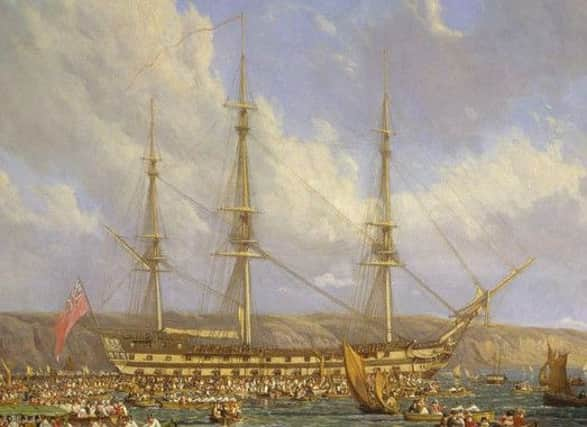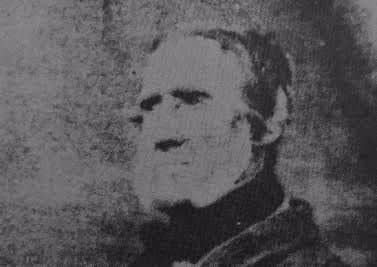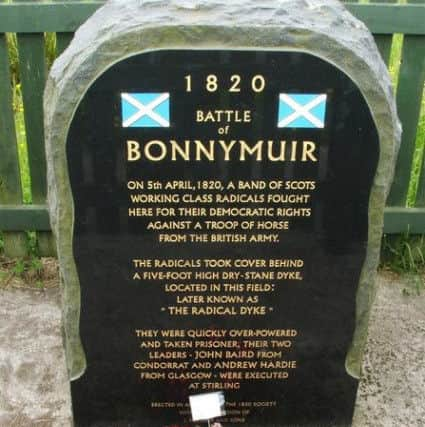The Scottish '˜radicals' taken to Australia on convict ships


Nineteen men in total were banished following the Battle of Bonnymuir near Bonnybridge on April 5 of that year, a time of deep working class disillusionment with the Tory government of the day.
Unrest had reached “fever pitch” amongst skilled workers struggling with low pay triggered by the end of the Napoleonic Wars and the Industrial Revolution.
Advertisement
Hide AdAdvertisement
Hide AdIt came against shifting view of equality as triggered by the French Revolution and the growing influence of Thomas Paine’s Rights of Man and its call for universal suffrage for all men. By the time of Bonnymuir, the Luddites had already smashed up their machines in England.


The government responded with new laws to limit dissent, with freedom of speech and freedom of assembly curtailed. A network of agent provocateurs were at work in Scotland to pinpoint the dissenters.
A poster pinned up around Glasgow on April 1 1820 triggered the climax of the discontent in Scotland - it was later said the government itself had pinned it up to draw out the Radicals.
It set out how men were “reduced to take up arms for the redress of our common grievances...” and called for others to “desist from their labour...and attend wholly to the recovery of their rights.”
It spurred around 40 men to gather and head to the Carron ironworks near Falkirk to stockpile ammunition.


But they were driven towards the battle spot by a government spy - into the line of the waiting cavalry.
Following a fierce outlay of violence, 18 men were captured at Bonnymuir including two radical leaders, Andrew Hardie of Glasgow and John Baird of Condorrat.
Advertisement
Hide AdAdvertisement
Hide AdThey were executed, hung and beheaded outside the Court House in Stirling with their fellow fighters to stand trial in Edinburgh.
Nineteen in total were sent to Australia, convicted of high treason with seven sentenced to transportation for life.


All were pardoned by King William IV in 1835 but many choose to stay in Australia, where some forged great, prosperous lives and in many cases became men of influence.
Here we look at 11 men who were transported to New South Wales following the Battle of Bonnymuir - and what became of them.
THOMAS MCCULLOCH


Born in County Down, McCulloch was a stocking maker living in Glasgow at the time of the uprising. He was subsequently sentenced to 14 years transportation. In a letter home to his wife, he said: “The whole of our party is much respected here by the most respectable people in this country, and if you will only come out, a steady man and woman can do well, as they are very rare articles to be found here. In 1823, his wife and two sons arrived in New South Wales. After gaining a certificate of freedom, McCulloch ran The Sydney Arms public house and subsequently bought land in the city and around New South Wales. His family prospered and his son and grandson practised law and became prominent in legal circles.
Another of the radical’s grandsons, Dr Stanhope Hastings McCulloch, became one of Australia’s greatest obstetricians after returning to Edinburgh to study.
Other descendants include Allan Riverstone McCulloch, considered a world authority on fish and writer Eleanor Dark.
JOHN ANDERSON
Advertisement
Hide AdAdvertisement
Hide AdBorn in Camelon, he was described as a quiet, conscientious man with a small left eye who was aged 27 at the time on Bonnymuir. After arriving in Australia, the former weaver - also remembered for his good singing voice - became a teacher of the Presbyterian School at Portland Head.
JOHN BARR
Born in Glasgow, Barr lived in Condorrat at the time of the uprising. A weaver by trade, he had a slightly pockpitted face, a sallow complexion and brown hair. He arrived in Australia aged 27 and worked in the Government weaving loft attached to the jail of Paramatta. He received a Certificate of Freedom in January 1928 and returned to Liverpool in later life, some 41 years after his transportation.
WILLIAM CLACKSON
Small, with a ruddy complexion and dark grey eyes, the shoemaker from Glasgow was sentenced to 14 years transportation for his part in the Battle of Bonnymuir. He was so badly wounded that he was held at Stirling for four weeks before being sent to join the others in Edinburgh. He had four wounds to his head and was shot through the arm.
JAMES CLELLAND
Came within days of being executed at Stirling but following a rethink of his case by Lord Sidmouth, was transported to Australia for life. The blacksmith, from Glasgow, was born in Edinburgh but ‘radicalised’ in the west. In Australia, he lived in Sydney with his wife Mary and fellow deportee and radical Alexander Johnstone.
ALEXANDER JOHNSTONE
The youngest prisoner captured at Bonnymuir and only 15-years-old. From Lanarkshire, it is said that government troops were called to save the ‘spirited boy’ as he sat reloading and firing his pistol. But his age incurred no leniency and he was sentenced to 14 years’s transportation. He worked as the principal servant to Commissionary General in Australia and was later the licensee of The Woolpack Inn in Sydney.
ANDREW DAWSON
Dawson escaped Bonnymuir but was picked up by Government troops near Camelon. At his trial, he was referred to by the Lord Advocate as one of the “most criminal at your Lordship’s bar.” He was born in Stirlingshire around 1782 and had a dark complexion and grey facial hair. He worked for the government in Sydney and in February 1882 lodged an application to have his wife and six children from Camelon sent to New South Wales. It is not clear if they arrived and Dawson applied to marry a convict in 1834.
ROBERT GRAY
Born in Berwickshire, Gray was born in Berwickshire and was a weaver by trade. He was one of seven sentenced to life transportation. He was employed first by public works and secondly as a schoolmaster at Hobart Town.
ALEXANDER HART
Advertisement
Hide AdAdvertisement
Hide AdThis weaver from Old Kilpatrick, near Glasgow, was scarred for life following Bonnymuir with a cut between his eyebrows. He was transported for 14 years. He was assigned to a magistrate who became superintendent of the ‘female factory’ worked by convict women. Men of the colony would visit the factory to find a wife and in May 1822, Hart married Irish convict Bridget O’Heara.
THOMAS McFARLANE
The oldest of the radicals, McFarlane moved to Condorrat from Glasgow to work in the weaving trade. He was one of three men hospitalised at Stirling Castle due to the heavy wounding he took at Bonnymuir. It is understood he returned to Scotland after receiving his Royal Pardon. His wife and mother to his six children died before he was able to return to her.
JOHN McMILLAN
A blacksmith by trade, he has been desribed as the tallest of all the radicals at 5ft 10ins tall. One of the seven to receive life sentences, McMillan, from Falkirk, continued to work as a smithy in the Government Service on arrival in Australia. After receiving his certificate of freedom in 1827, he wrote to his wife Jean about his purchase of another house for £100 and instructed her to be ready to set sail to Australia at short notice, with information on passage due shortly in the post. She arrived with her three daughters in Sydney three months later.
McMillan later became active in the church and is remembered as a man who wore a top hat, drove a white horse, kept beehives and numerous cats. He was the last survivor of the radicals, dying in 1877 aged 84.
Other radicals banished to Australia were Benjamin Moir, 36. a labourer of Glasgow; Allan Barbour Murchie, 24, a blacksmith from Dunfermline who later moved to New Zealand, Thomas Pike (or Pink), 21, a weaver from Glasgow; William Smith 41, a weaver originally from Ireland but later of Condorrat; David Smith, 23, a weaver from Glasgow who later became a shepherd.
Andrew White, 16, a Glasgow weaver, worked as a house servant in Australia but returned home just three years later after receiving an absolute pardon by the Governor of Brisbane. James Wright, a 30-year-old tailor from Glasgow, was the final radical to arrive in Australia. Little is known of what happened to him.
